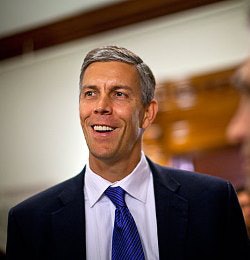 Arne Duncan, secretary of the Department of Education, says the estimated 9 million students that the proposed plan would help could in reality “go significantly higher.”
Arne Duncan, secretary of the Department of Education, says the estimated 9 million students that the proposed plan would help could in reality “go significantly higher.”More details on the proposed congressional bill to make two years of college free were revealed on Wednesday morning. Rep. Bobby Scott, D-Va., Sen. Tammy Baldwin, D-Wis., and Secretary of the Department of Education Arne Duncan held a press call to discuss logistics.
Scott and Duncan said that they expect the proposed bill, America’s College Promise Act, will impact at least 9 million students attending community colleges and minority-serving institutions. Duncan said that he anticipated that 9 million might be a low estimate.
“I’m actually hopeful and optimistic that many more students across the nation, as this becomes a reality, will start to think how college isn’t just for rich folks; it’s for people like me. Conceivably that number could go significantly higher,” Duncan said. The education secretary added that the success of state initiatives such as the Kalamazoo Promise and Tennessee Promise show that, once implemented, there is great public interest and support for “free” college.
Under the proposed bill, eligible students could expect to save $3,800 on average each year. The federal government would foot 75 percent of costs, and states the remaining 25 percent.
The plan would include certain stipulations for public institutions, including reforms aimed at improving academic quality and student outcomes that they would be expected to undertake. Baldwin said that the bill would require that credits from two-year institutions be fully transferable to four-year institutions. She said that this would require “greater coordination” between two-year and four-year institutions.
However, by strengthening the link between two-year and four-year institutions, Duncan said that four-year colleges would also be beneficiaries of the bill. “A rising tide lifts all boats,” he said, “If you have many more people going to enroll in community colleges and graduate with better pathways into four years, then everyone is going to do well there.”
President Barack Obama first proposed the idea of making community college free for certain high school graduates in January. Since then, several plans aimed at lessening the burden of college costs have been proposed.
The America’s College Promise Act extends beyond community colleges to students at minority-serving institutions (MSIs). It would create a grant program for students attending MSIs, including historically Black colleges and universities, Hispanic-serving institutions, and Asian American and Pacific Islander-serving institutions. Qualifying students at MSIs would have their first two years of college tuition and fees reduced. The bill would also make tuition free at tribal colleges.
Baldwin said that the expanded plan was expected to cost $90 billion over 10 years, broken down into $80 billion for community college and $10 million for minority-serving institutions. The price tag for Obama’s original proposal was $60 billion over 10 years.
Scott said that the bill had 61 co-sponsors in the House so far, and Baldwin said that the Senate had 10. “We have not officially introduced the bill and may gather more [support] prior to introduction. So far it is all Democrat,” Baldwin said. “We certainly want to see it become bipartisan.”
Staff writer Catherine Morris can be reached at [email protected].





















